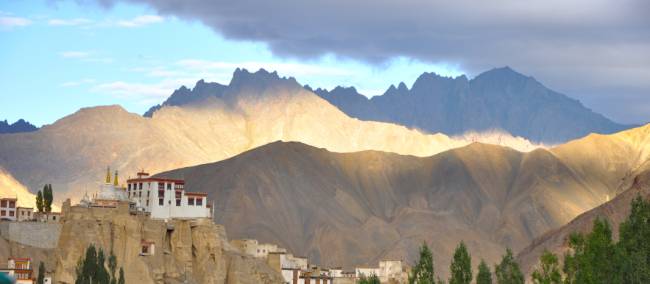
Lamayuru Monastery in Leh | Garry Weare
If you're intent on discovering wild and remote lands, then consider a trek in the Zanskar region of the Indian Himalaya, the most isolated region of Ladakh.
If you prefer your treks to offer a truly off-the-beaten-track destination that is unspoiled, offers dramatic and challenging landscapes as well as cultural richness, keep reading.
Where is Zanskar, and why should I visit?
Zanskar is relatively remote and one of the less trekked regions in the Himalaya. Enclosed by spectacular high mountains – including the snow-capped peaks of the Great Himalaya and the rugged Zanskar Range - it sits in the northen part of India, in the region of Ladakh.
The Buddhist region of Zanskar is a Trans Himalayan land, showcasing an ancient Tibetan culture reflected in its exquisite Buddhist monasteries where the turn of the prayer wheel turns in harmony with the seasons and where tiny, whitewashed settlements extend to the borderlands of Tibet.
A trek through Zanskar will introduce you to many remote villages and monasteries where the way of life has been unchanged for generations.
When is the best time to visit?
There is a very narrow window of opportunity to trek in Zanskar. In winter, with the exception of the walking down the icebound Zanskar river, the region is isolated, cut off by snow that precludes local people from travelling to other regions of Ladakh for seven months of the year.
Zanskar lies beyond the influence of the Indian monsoon with a trekking season that extends from when the snow melts on the passes in June until the first snows settle on the same passes in late October.
September is the only feasible month to complete treks through the remote and rugged gorges. September is also when the water levels drop, making it possible to undertake the many river crossings required when trekking through Zanskar – and yes, there are many, so come prepared!
Will I see a snow leopard?
In Zanskar’s outlying gorges and passes herds of bharal or blue sheep graze on scant pastures, ibex roam the cliff tops, and brown bears are regularly seen close to many settlements.
As for the elusive snow leopard, the chances of seeing a cat are still on par with winning the lottery. However, due to the good work of the Snow Leopard Conservancy, there is evidence of increasing numbers. Birds of prey are a further attraction. Golden Eagles and lammergeier soar the thermals in search of prey and carrion.
Zanskar's Buddhist legacy
With its deep seated Tibetan traditions, Buddhism defines the high culture of Zanskar.
Ancient monasteries, dating back to the 11th century, located on top of sugarloaf mountains or carved out of precipitous cliff faces characterise this rugged land.
Colourful prayer flags fluttering on the high passes, mani walls – some of the longest in the Himalaya – together with impressive chotens along the trails, add a constant reminder of Zanskar’s enduring Buddhist legacy.
Is it still possible to trek in Zanskar?
Many companies still promote trekking itineraries in Zanskar that follow roads. Since the early 2000s, road developments have completely changed the landscape for those seeking a truly remote trekking experience, and our team has ensured that we have found new, less travelled paths.
The classic treks that extended across Zanskar are now roads. Most of the treks included in Garry Weare’s Lonely Planet Trekking in the Indian Himalaya guide are no longer possible, making it increasingly difficult to devise itineraries that avoid roads, but this shouldn't stop anyone from considering trekking in Zanskar.
Zanskar: the adventurous years – an aside
Ladakh was open to tourists in 1974, and Zanskar two years later. Our experience in the region stems back to this time.
In October 1979, veteran World Expeditions guide, Garry Weare, led the first rafting expedition down the Zanskar to the confluence of the Indus River.
While road development have changed the landscape, it is still possible to enjoy trekking in Zanskar - just come prepared for the challenging terrain and river crossings.
All in all, Zanskar is a unique destination that is a must-visit for any adventurer worth their salt. Its spectacular landscape, ancient Tibetan culture, and exotic wildlife make it a perfect destination for trekking enthusiasts.
View all Indian Himalayan treks






